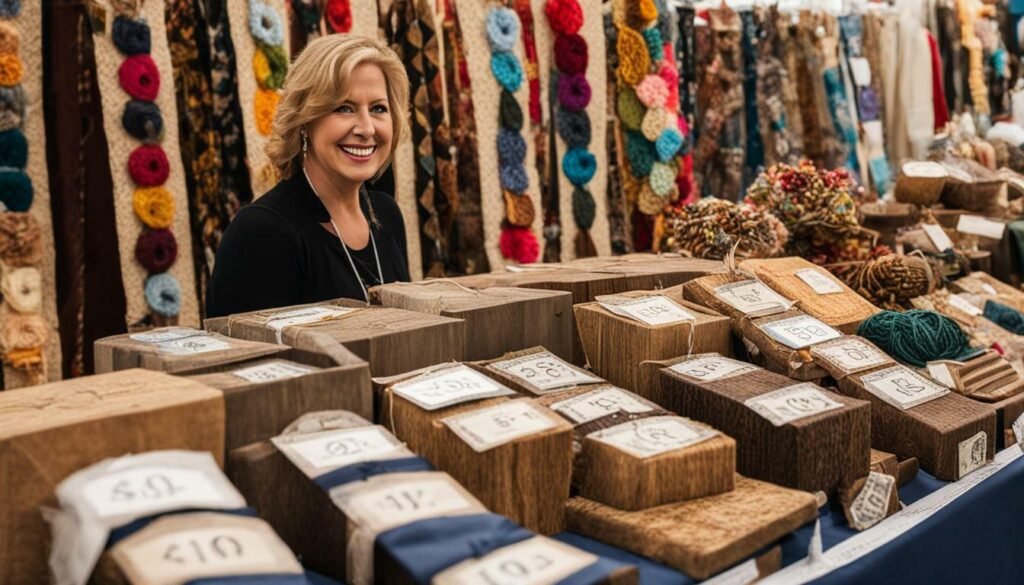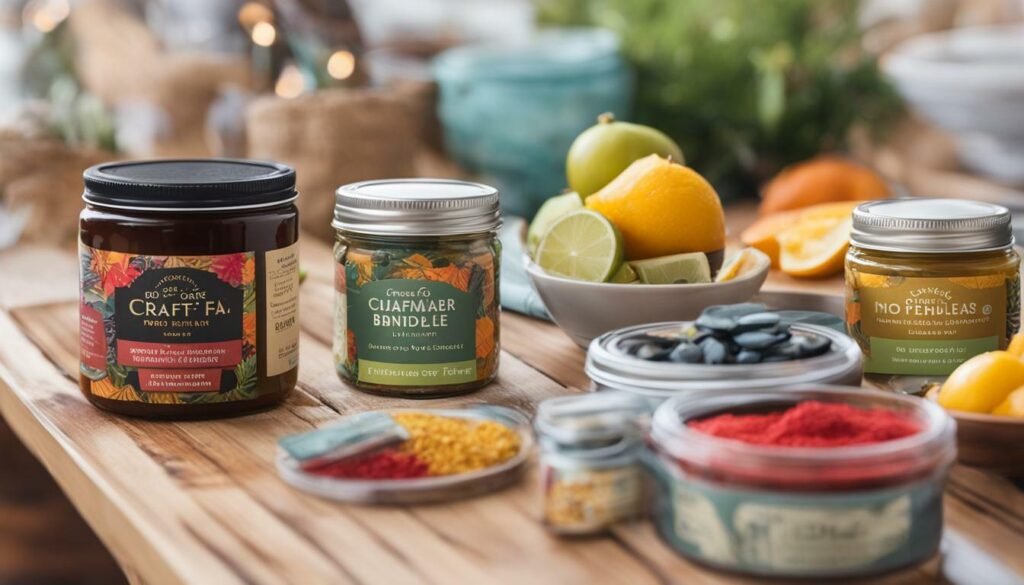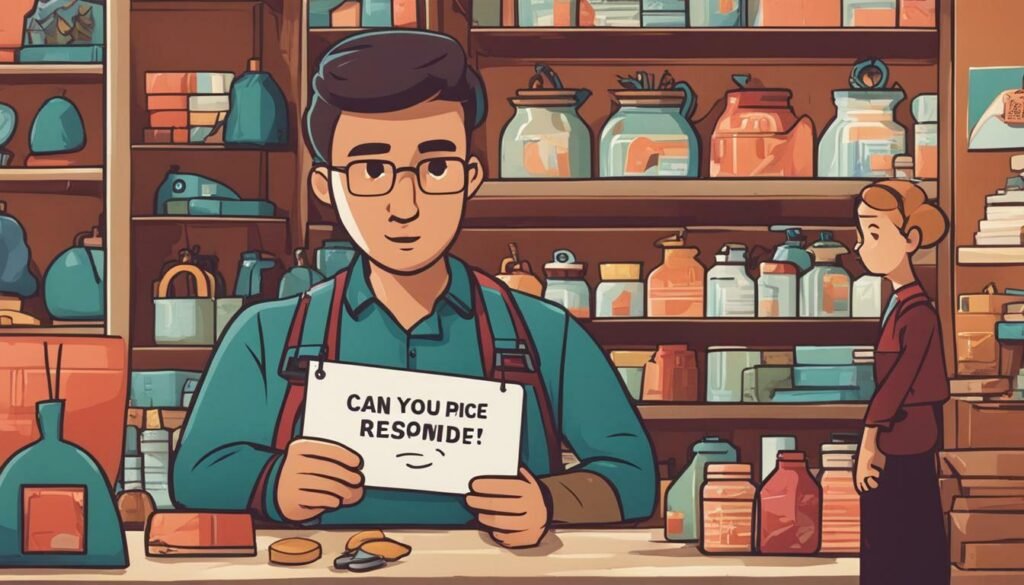Pricing your crafts for maximum profit at craft fairs can be a challenging task. You want to make sure your handiwork is rewarded, but also set prices that attract customers and boost sales.
Calculating costs for craft fair pricing is key, as is understanding the market and competition to ensure your prices are competitive and profitable.
- Calculating costs for craft fair pricing is essential for setting a fair and profitable price
- Understanding the market and competition is crucial for competitive pricing
- Setting a profit margin strikes a balance between profitability and competitiveness
- Assessing the value of your crafts helps communicate their worth to customers
- Testing and adjusting prices can optimize your craft fair pricing strategy over time
Understanding the Market and Competition
When pricing your crafts for a craft fair, it’s important to understand the market and your competition. Conduct research to determine similar crafts being sold in your area and at what price point. This will help you stay competitive and profitable.
- Visit other craft fairs and observe pricing trends for your category of crafts.
- Research online marketplaces and see what similar crafts are selling for.
Once you have an idea of the market and competition, you can start determining your own pricing strategy. Keep in mind that pricing too high or too low can have negative effects, but finding the sweet spot can lead to great success.
Here are some essential craft fair pricing strategies to help you calculate the costs and expenses associated with producing your crafts:
- Estimate the cost of all raw materials used to produce each item.
- Include additional expenses such as packaging, transportation, booth fees, and marketing.
- Calculate the time spent on each item and the hourly rate you want to earn.
- Factor in any tools or equipment used and the depreciation value for each item produced.
Determining Profitable Craft Fair Prices: Strategies for Craft Fair Vendors
After calculating your costs and expenses, it’s time to set a profit margin for your crafts that takes into account market trends, competition, and the value of your products. Here are some pricing strategies to consider:
- Factor in the competition: Research what similar crafts are selling for at the fair and set prices accordingly. Avoid undercutting your competitors too much, as this can lead to a perception of lower quality or desperation.
- Use pricing formulas: Consider using pricing formulas like the cost-plus pricing or value-based pricing to ensure a fair profit margin.
- Consider market demand: If a certain craft category is in high demand, you may be able to set slightly higher prices. Conversely, if a category is oversaturated with vendors, you may have to be more competitive with your pricing.
- Be flexible: Don’t be afraid to adjust your prices based on customer feedback and sales data. If you’re not selling as much as you’d like, consider lowering prices or offering bundle deals to attract more customers.

When setting prices for your crafts at a craft fair, it’s crucial to accurately assess their value to ensure you’re not selling yourself short.
- Consider the level of skill and time that went into making the craft. If it required a high level of craftsmanship or took you a long time to complete, it should be priced accordingly.
- Take into account the quality of the materials used. If you used high-quality materials that are more expensive, your craft should be priced higher.
- Think about the uniqueness of your craft. If it’s one-of-a-kind or has a distinctive design, it may be worth more than similar items.
Make sure to highlight the factors that make your craft special and use signage or labels to showcase its value. By effectively communicating the value of your crafts, you can set attractive prices that will appeal to customers while still rewarding your hard work.
When it comes to pricing your crafts, different categories may require different strategies to ensure competitive and profitable pricing. Here are some considerations for popular craft categories:
- Handmade Jewelry: Pricing for handmade jewelry may depend on factors such as the type of metal used, the complexity of the design, and the cost of gemstones or beads. You may consider pricing by the hour or per piece, with a markup of 2.5 or 3 times the cost of materials.
- Home Decor: When pricing home decor items, you may need to account for the cost of materials as well as the time spent on designing and creating the item. Pricing by size or complexity may be a good strategy, with a markup of 2 to 2.5 times the cost of materials.
- Clothing: Clothing items may require factoring in fabric costs, pattern design, and time spent on sewing. You may consider pricing by the hour or by item, with a markup of 2 to 2.5 times the cost of materials.

Below are some pricing strategies tailored to specific craft categories:
- Handmade Jewelry: With jewelry, the materials alone can significantly affect the pricing. Consider using materials that are both affordable and of good quality. Consider offering bundle pricing for multiple items to entice customers to purchase more.
- Home Decor: Pricing for home decor should consider factors such as the complexity of the piece and the materials used. Unique, high-quality materials can potentially warrant a higher price point. A set price for similar items like a matching set of pillows is also a good strategy.
- Clothing: When pricing clothing items consider the cost of materials, the level of skill involved in crafting the garments, and the level of competition. You may want to provide bundle pricing when a customer buys multiple items, like a blouse and skirt, or have a set pricing strategy based on the types of items (shirts, dresses, etc.)
Remember to research similar products in your category and adjust your pricing strategy accordingly. If you’re unsure, start with a slightly lower price point and adjust as needed based on sales data. The goal is to strike a balance between profitability and competitiveness.

For small local fairs, you may have a more intimate customer base and lower overhead costs, so you may be able to price your crafts a bit higher. For larger trade shows, you’ll likely have a more diverse customer base and higher competition, so you may need to consider lower prices to stay competitive.
Online craft markets may require lower prices to stay competitive, but you can make up for it in volume sales. Consider your expenses, including booth fees, travel costs, and production costs, and factor them into your pricing strategy.
If you’re unsure about how to price your crafts for different craft fair sizes, do your research by checking out similar products on display at each event.

Here are some tips for testing and adjusting prices:
- Conduct pricing experiments by slightly varying prices for the same product and comparing sales and customer feedback.
- Analyze your sales data and customer feedback to identify pricing patterns and trends.
- Consider current market trends, competition, and customer preferences when making adjustments to your pricing strategy.
- Regularly monitor your pricing strategy and make necessary adjustments to stay competitive and profitable.

One of the key elements of effective craft fair pricing is ensuring that potential customers can see your prices clearly and quickly.
This means that you need to find ways to display your prices that are attractive and attention-grabbing, but not distracting or overwhelming.
Here are some tips for displaying price information effectively:
- Use clear and readable signage: Make sure that your prices are easy to read from a distance, even in crowded or dimly lit environments. Use bold fonts, clear colors, and consistent labeling to help customers quickly identify your prices.
- Consider pricing tiers: If you have crafts at different price points, consider using different pricing tiers to help customers quickly identify the price range for each item. For example, you could use different colored labels for items under $10, between $10 and $20, and over $20.
- Use price tags or labels: Attach price tags or labels to your crafts, rather than relying on verbal communication. This can help customers quickly identify the price of an item, without having to ask or search for signage.
- Highlight special promotions: If you are offering special pricing or promotions, make sure to highlight these prominently in your display. Use signage or labels to draw attention to these offers, and explain the benefits clearly.
- Don’t overshadow your crafts: While you want to make sure that your prices are visible, you don’t want to overshadow your crafts themselves. Avoid using overly large or flashy signage that detracts from the beauty and uniqueness of your items.
Offering discounts is a common occurrence at craft fairs, but it’s important to navigate these requests carefully to ensure your profitability. Here are some tips:
- Consider offering bundle deals or free gifts instead of direct discounts.
- Set a limit on the amount of discount you’re willing to give, such as a maximum percentage off or a minimum purchase amount.
- Be confident in your prices and the value of your crafts, and politely explain the reasoning behind your pricing decisions.
- Assess the potential impact on your business before agreeing to any discounts.
- Remember that discounts should be the exception, not the rule. Your prices should be set to ensure your profitability, and you should only make exceptions in limited circumstances.

Here are some tips for determining profitable craft fair prices and making necessary pricing adjustments:
- Regularly analyze your sales data to identify pricing trends and patterns
- Track your expenses and adjust your prices accordingly to maintain profitability
- Stay up to date with market trends and competition to remain competitive
- Consider seasonal demand and adjust prices accordingly
- Regularly gather feedback from customers to assess the value of your crafts and identify opportunities for price optimization

Here are some tips for engaging with customers on pricing:
- Be transparent about your pricing strategy and explain the factors that go into determining the price of your crafts, such as material costs, labor, and overhead expenses.
- Highlight the value and craftsmanship behind your crafts, and emphasize the uniqueness and quality of your products.
- Offer suggestions for alternative products or options that may fit their budget if they express interest but can’t afford the current price.
- Consider offering discounts for bulk purchases or repeat customers to incentivize sales while maintaining profitability.
- Listen to customer feedback and take it into account when adjusting your pricing strategy.
Craft fair pricing may seem daunting at first, but with the right strategy, you can set prices that reward your handiwork and attract customers to boost your sales.
- Understand the market and competition to ensure your prices are competitive and profitable
- Calculate all costs and expenses associated with crafting your products
- Set a profit margin that strikes the right balance between profitability and competitiveness
- Assess the value of your crafts and communicate it effectively to potential customers
- Consider pricing strategies for different craft categories and fair sizes
- Display price information effectively without overshadowing your crafts
- Monitor and adjust your prices over time to stay competitive and profitable
- Engage with customers on pricing inquiries and educate them on the value and craftsmanship behind your crafts
FAQs
What factors should I consider when calculating costs for crafting fair pricing?
When calculating costs for craft fair pricing, consider factors such as the cost of materials, labor, packaging, and any additional expenses.
How do I set a profit margin for my crafts at craft fairs?
Setting a profit margin for your crafts involves striking the right balance between profitability and competitiveness.
How can I assess the value of my crafts to set attractive prices at craft shows?
Assessing the value of your crafts involves considering elements such as uniqueness, quality, and craftsmanship. By effectively communicating these values to potential customers, you can set attractive prices at craft shows.
Are there different pricing strategies for different craft categories?
Yes, different craft categories may require specific pricing strategies. Factors such as market demand, materials used, level of skill, and competition within each category should be considered when setting prices for crafts at craft fairs.
How effective are bundle pricing and special offers at craft fairs?
Bundle pricing and special offers can be effective strategies for attracting customers and boosting sales at craft fairs. By strategically packaging your crafts, you can enhance their perceived value and encourage customers to make purchases.
Should I adjust my prices based on the size of the craft fair?
Pricing may vary for small local fairs, large trade shows, or online craft markets. Adapt your prices accordingly to ensure competitiveness and profitability.
How can I test and adjust my prices to optimize my craft fair pricing strategy?
Testing your prices, gathering customer feedback, and making adjustments are essential steps in optimizing your craft fair pricing strategy.
What are effective ways to display price information at craft shows?
Displaying price information effectively is crucial at craft shows. Use clear signage and labeling techniques to ensure your prices are visible and appealing to customers without overshadowing your crafts.
How should I handle discount requests at craft fairs?
When handling discount requests at craft fairs, consider negotiating when appropriate and explore alternative ways to provide value to customers. Maintain a fair balance between customer satisfaction and profitability.
What are some final thoughts on craft fair pricing?
Craft fair pricing is a strategic and balanced process. It’s crucial to find the right balance between rewarding yourself for your handiwork and setting prices that attract customers.
